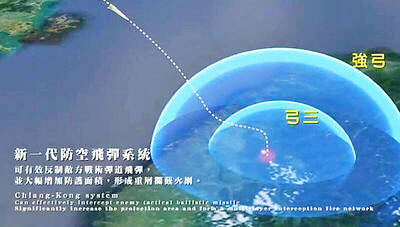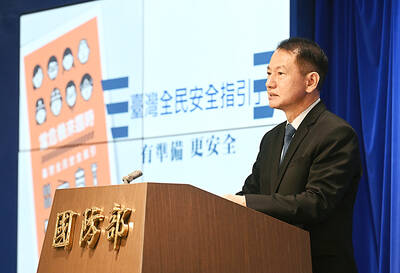Captain Mineo Hirata and the 280 sailors on board the Japanese navy destroyer JS Kongo will attempt to shoot a ballistic missile out of space today -- a first for Tokyo or any US ally.
The joint Japan-US test off Hawaii comes almost 10 years after North Korea launched a long-range missile that flew over Japanese territory and splashed into the Pacific Ocean, spurring an alarmed Tokyo to invest billions in missile defense.
"There are countries near us that possess ballistic missiles," Hirata told reporters on a Pearl Harbor pier before the Kongo headed out to sea. "This [the test] is very important for the defense of our nation, for the protection of our people and property."
Experts say the test of the Standard Missile-3 interceptor will likely strengthen the US-Japan defense alliance.
But it may also deepen concerns in Beijing that Tokyo could use the technology to help the US defend Taiwan if conflict erupted across the strait.
The Pacific Missile Range Facility on Kauai, run by the US Navy, will fire the target missile into the sky. The USS Lake Erie, a Pearl Harbor-based guided missile cruiser, will track the missile target and feed information on it to a command center.
The medium-range test target is expected to resemble Pyongyang's Rodong missiles, which are capable of flying about 1,000km -- or far enough to put Tokyo and much of Japan within their range.
The Rodong has a shorter range than the Taepodong-1 missile that flew over Japan in 1998.
But the Rodong, of which North Korea is believed to possess about 200, represents the biggest security threat to Japan, said retired vice admiral Fumio Ota, the director of the Center for Security and Crisis Management Education at the National Defense Academy of Japan.
"If we have midcourse missile destruction capability, we would significantly improve our missile defenses," said Ota, a former director of Japan's defense intelligence headquarters.
US Navy ships have successfully intercepted medium-range ballistic missiles in space in previous tests.
Today's drill will see if Japan can do similarly, even though the AEGIS ballistic missile defense system it has on board has been modified slightly to suit Japanese ship specifications.
Bruce Bennett, a senior defense analyst at the RAND Corp, said that even if the Kongo succeeds, it will be a couple of years before Japan installs enough missile interceptors on board its ships to substantially boost its capabilities.
Ota said the test would bolster a US-Japan alliance that has suffered from two recent setbacks.
One involves allegations that a Japanese lieutenant commander leaked classified data involving the AEGIS system. Police arrested the officer on Thursday.
The other is Tokyo's suspension of a program to refuel US ships supporting coalition forces fighting in Afghanistan, Ota said. Japan had to end the refueling mission when the government failed to win enough opposition votes for a bill that would have extended the program.

LIMITS: While China increases military pressure on Taiwan and expands its use of cognitive warfare, it is unwilling to target tech supply chains, the report said US and Taiwan military officials have warned that the Chinese People’s Liberation Army (PLA) could implement a blockade within “a matter of hours” and need only “minimal conversion time” prior to an attack on Taiwan, a report released on Tuesday by the US Senate’s China Economic and Security Review Commission said. “While there is no indication that China is planning an imminent attack, the United States and its allies and partners can no longer assume that a Taiwan contingency is a distant possibility for which they would have ample time to prepare,” it said. The commission made the comments in its annual

DETERMINATION: Beijing’s actions toward Tokyo have drawn international attention, but would likely bolster regional coordination and defense networks, the report said Japanese Prime Minister Sanae Takaichi’s administration is likely to prioritize security reforms and deterrence in the face of recent “hybrid” threats from China, the National Security Bureau (NSB) said. The bureau made the assessment in a written report to the Legislative Yuan ahead of an oral report and questions-and-answers session at the legislature’s Foreign Affairs and National Defense Committee tomorrow. The key points of Japan’s security reforms would be to reinforce security cooperation with the US, including enhancing defense deployment in the first island chain, pushing forward the integrated command and operations of the Japan Self-Defense Forces and US Forces Japan, as

INTERCEPTION: The 30km test ceiling shows that the CSIST is capable of producing missiles that could stop inbound missiles as they re-enter the atmosphere Recent missile tests by the Chungshan Institute of Science and Technology (CSIST) show that Taiwan’s missiles are capable of intercepting ballistic missiles as they re-enter the atmosphere and pose a significant deterrent to Chinese missile threats, former Hsiung Feng III missile development project chief engineer Chang Cheng (張誠) said yesterday. The military-affiliated institute has been conducting missile tests, believed to be related to Project Chiang Kung (強弓) at Pingtung County’s Jiupeng Military Base, with many tests deviating from past practices of setting restriction zones at “unlimited” and instead clearly stating a 30.48km range, Chang said. “Unlimited” restrictions zones for missile tests is

PUBLIC SAFETY: The nationwide distribution campaign aims to enhance society’s overall understanding of threats and bolster defense awareness, an official said The latest edition of the National Public Safety Guide is being mailed to all citizens starting today to foster public awareness of self-defense in the event of war or natural disasters, the Ministry of National Defense said yesterday. “The guides will be disseminated to the public to enhance society’s overall understanding of threats and bolster defense awareness, demonstrating the government’s emphasis on people’s safety and its determination to pursue self-defense,” All-out Defense Mobilization Agency Director Shen Wei-chih (沈威志) said at the ministry’s news conference. The nationwide distribution campaign was planned according to President Lai William’s (賴清德) Sept. 20 directive, he said, adding